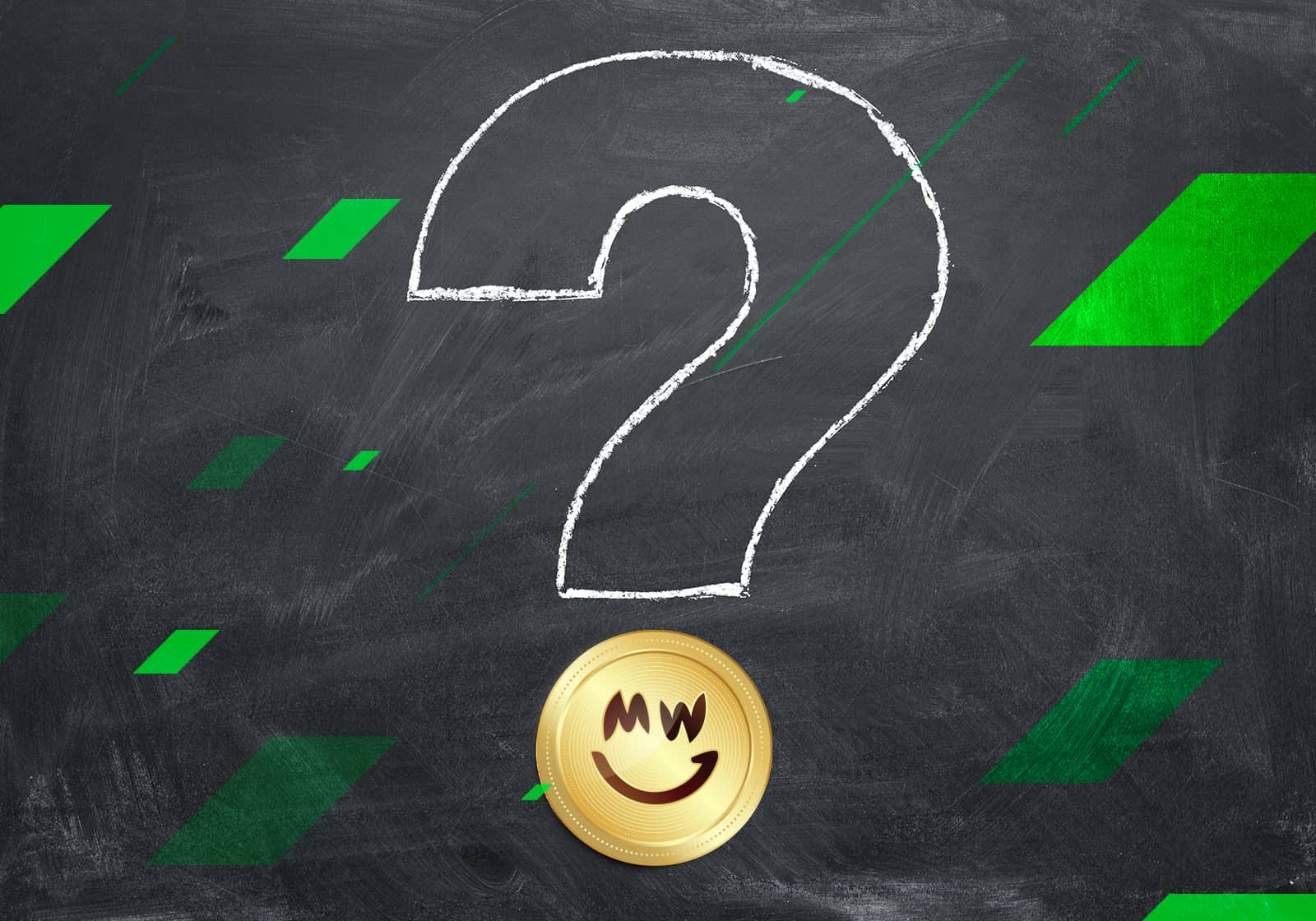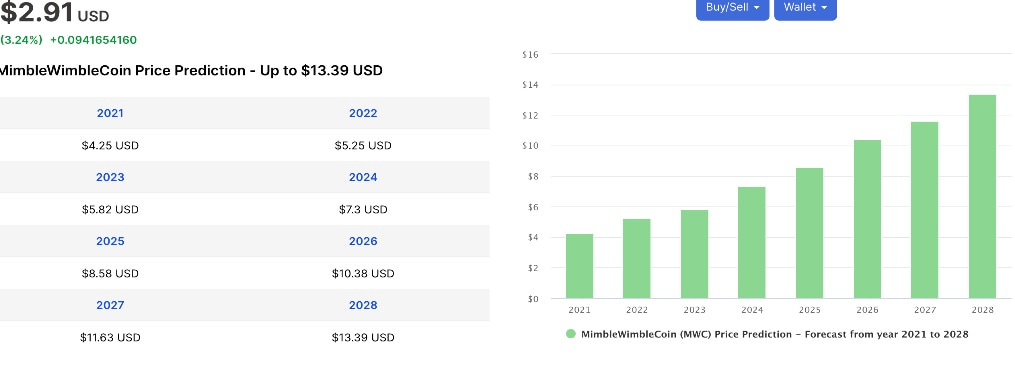What Is Mimblewimble Coin (MWC)?

Mimblewimble is more than a strange word for avid Harry Potter fans; it’s a blockchain protocol that addresses privacy to a higher degree than Bitcoin or other blockchains.
In the modern world, when most of us are concerned about online privacy, the Mimblewimble protocol offers more advanced security measures that can’t compare to other blockchains in the industry.
What’s Mimblewimble, how does it work, and what are its price predictions? Let’s learn more about one of the safest protocols in the cryptocurrency world.
The Story Behind Mimblewimble Coin (MWC)
In June 2016, Tom Elvis Jedusor shared the Mimblewimble whitepaper on a Bitcoin research channel. Interestingly, the name of the whitepaper’s author refers to the villain in the Harry Potter novels: Voldemort, whose real name was Tom Marvolo Riddle. Tom Elvis Jedusor is Voldemort’s name in the French translation of the books, and ‘Mimblewimble’ is a spell from Harry Potter that prevents your opponent from accurately casting their next spell.
Before introducing the Mimblewimble crypto coin, there was an idea to improve the Bitcoin blockchain by implementing a more scalable and confidential protocol. In the whitepaper, Jedusor proposed creating a blockchain protocol that would increase privacy, scalability and fungibility by hiding senders’ and receivers’ names. The process was rather complicated, and the release of the Mimblewimble coin was considered a better solution.
Interestingly, the Mimblewimble whitepaper was released one month before the Bitfinex hack in August 2016, when hackers reached the crypto exchange’s system and stole $72 million worth of Bitcoin. The Bitfinex hack brought more credibility to the idea standing behind the Mimblewimble protocol and gave it a major push for secure cryptocurrency trading.
Mimblewimble Explained
Mimblewimble is a blockchain protocol that allows cryptocurrency transactions to remain completely anonymous. It keeps the sender’s and receiver’s addresses and transactions fully confidential.
The key MWC feature is the HODL programme, which rewards MWC addresses with zero negative movements during a predetermined period. In such a way, the protocol’s developers encourage MWC owners to store their coins on the wallet without any movement for longer periods of time to generate more profit. By doing so, the HODL programme rewards users for simply having WMC on their wallets without needing to lock in anything (unlike Ethereum, which encourages users to lock their ETH in smart contracts).
The Mimblewimble Protocol
To understand the Mimblewimble protocol, one should first understand how MW transactions are conducted.

Mimblewimble crypto coin transactions derive from confidential transactions introduced by Adam Back, the former Bitcoin developer. With confidential transactions, senders can encrypt the number of bitcoins they want to send using the blinding factor, a random value of bitcoins selected by transaction senders. The blinding factor is used only for encryption purposes and does not affect the transactions’ input or output in any way.
Due to the confidential transaction, onlookers cannot see the number of bitcoins being moved. However, onlookers can still validate the transaction while comparing the number of inputs and outputs. The transaction is claimed to be valid when both factors match.
Mimblewimble token transactions work in a similar way. The only difference is that the recipient should randomly select the blinding factors’ range that the sender provided. This is used as proof of the transaction receiver’s ownership and permission for him/her to spend the coins.

Besides using confidential transactions, Mimblewimble token transactions are conducted using another innovative mechanism known as CoinJoin, which was originally proposed by Gregory Maxwell. With CoinJoin, payments from multiple senders are combined into a single transaction, making it impossible for onlookers to determine where transactions come from.
Currently, there are two implementations of the Mimblewimble protocol: Grin and Beam. Although both coins were proposed to facilitate private money transfers, they have different visions about privacy.
Grin is a cryptocurrency founded by a person under the pseudonym Ignotus Peverell (another fictional character from the Harry Potter novels). The Grin token is ICO-free and developed on Rust programming language. It was released on 15 January 2019 and came without an ICO, pre-mining or a founder’s reward.
The Grin cryptocurrency possesses many properties of the MW protocol, including no addresses, no visible transaction amounts, no transaction history and no fixed price. Privacy is mandatory in the Grin network: all transactions are private, all users are hidden, and the whole network is fully anonymous.
While mining Grin, miners must add the following in the block header:
- The latest target difficulty
- A set of transactions available for validation
- A coinbase transaction
- The current timestamp
- A randomly generated nonce
- The Merkle root of the UTXO set
Beam token is a different type of cryptocurrency based on the Mimblewimble protocol. It was presented by the entrepreneur Alexander Zaidelson on 30 January 2019. Unlike Grin, it’s built using C++. However, similar to Grin, Beam’s release was ICO-free.
The Beam coin is designed for selective privacy. Its goal is to provide users with anonymity when needed. The optional tracking for transactions and users is allowed, making Beam not as anonymous as Grin.
Mimblewimble vs Bitcoin
When compared to Bitcoin, MW stands out for three distinctive advantages:
- Anonymity. Unlike the Bitcoin network, where a public address represents every user, the Mimblewimble crypto coin has no addresses and doesn’t save transaction history. It makes it impossible to compromise MWC users’ anonymity.
- Fungibility. This refers to one unit of a currency being interchangeable with another unit without losing value. Let’s consider the following example. The open blockchain makes bitcoins trackable, meaning that a merchant may refuse to accept bitcoins labelled as ‘tainted.’ That’s not the case with the Mimblewimble Coin because there are no wallet addresses available, which makes it impossible for a merchant to check where the cryptocurrency originates from.
- Scalability. Unlike Bitcoin and its issue with scalability that was resolved by implementing a new crypto coin, Bitcoin Cash, MWC features a more scalable architecture thanks to transactions taking less space in a block. The space-saving peculiarity is specifically accentuated while performing the cut-through feature.
How Does Mimblewimble Work?
The Mimblewimble protocol doesn’t feature the addresses or transactions of each user. Instead, groups and records united in a single large transaction can be verified without requiring any individual details.
Each MWC transaction features three sets: a set of inputs, a set of outputs and a set of kernels. As previously mentioned, MWC doesn’t publicly reveal the amounts of money the inputs and outputs contain. The kernel, in turn, serves as proof of the transaction’s validity by:
- Confirming that the transaction hasn’t lost any coins or created new ones out of thin air: Σinput.amount - Σoutput.amount = 0
- Proving that the transaction is authentic, meaning that the sender and the receiver have agreed on it
Let’s consider the following example of the MWC transaction:

The transaction has a single input, two outputs and a kernel that pays a 0.011 fee. A third-party observer can’t see the transaction’s sender or receiver or the amount of the inputs and outputs. The only way to know this is by obtaining some metadata about the input and output, but that’s impossible to find out by just looking at the transaction details.
Mimblewimble Price
At the time of writing, the Mimblewimble Coin price stands at $2.913, but your current investment may lose value in the future.

Mimblewimble Price Prediction
According to DigitalCoinPrice’s forecast, MWC’s price is expected to rise to $14.50 by 2028. One MimbleWimbleCoin (MWC) may be worth as much as $5.02 in one year, which is nearly twice the current MimbleWimbleCoin price.

Mimblewimble Release Date
The MWC network was released in November 2019. Since then, the development has continued to progress, and multiple development resources have been allocated. The MWC development team looks forward to innovating and bringing out all of the Mimblewimble protocol’s benefits. They have already created a fully functional GUI wallet, developed a method for secure offline cold storage of MWC, implemented MWC/BTC atomic swaps, and are working on a mobile wallet and NIT, or non-interactive transactions.
There’s still more to be done. The highest priority right now is on managing requests coming from buyers and holders of last resort.
Mimblewimble Coin Exchange
MWC is currently traded on Hotbit, TradeOgre, Bitforex, Tokok, Whitebit, Biki and Bithumb Global. Each exchange offers varying degrees of security. To play it safe, it’s strongly recommended to withdraw your MWC to your personally controlled wallet.
Bottom Line
The Mimblewimble Coin is a great step forward in the online privacy world. Focusing on the full anonymity of each transaction, MWC has adopted one of the safest and most untraceable protocols among cryptocurrencies. That’s one reason why Grin and Beam have adopted the Mimblewimble protocol, which has led more people to view cryptocurrencies positively when considering using them.
Tags
Try our Bitcoin Cloud Miner and get additional crypto rewards based on your trading volume. It's immediately available upon registration.
Try our Bitcoin Cloud Miner and get additional crypto rewards based on your trading volume. It's immediately available upon registration.



